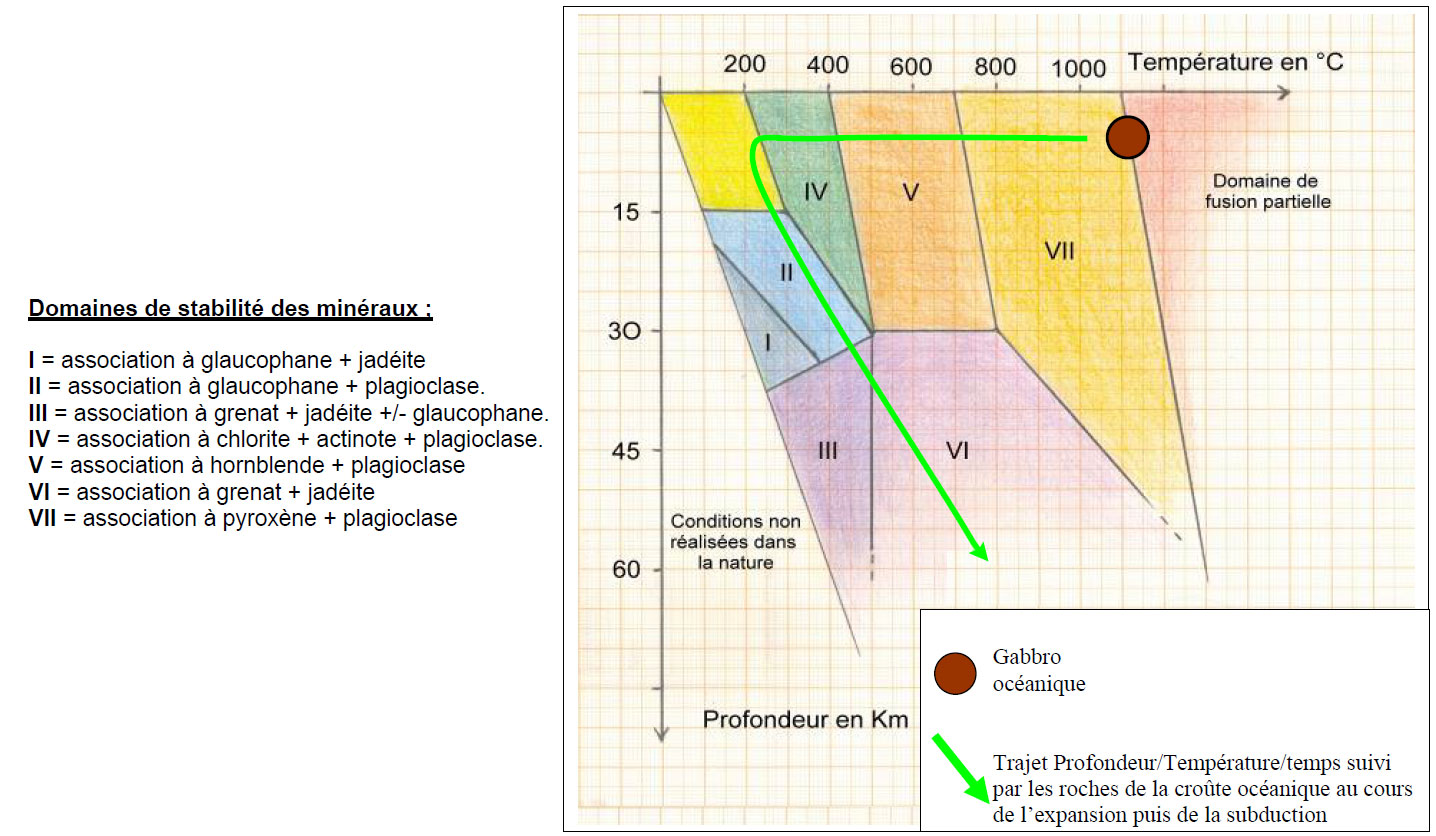Métagabbro à Glaucophane
Tout d'abord qu'est ce qu'un métagabbro ?
Un métagabbro est un gabbro ayant subi un métamorphisme. Le pyroxène (noir) et le feldspath plagioclase (blanc) ne sont alors plus, évidemment, les seuls minéraux composant la roche. Il est important de comprendre que les métagabbros ont des cristaux orientés à cause des contraintes tectoniques lors du métamorphisme qui les a créé. On peut citer :
• Les métagabbros du faciès amphibolite (à hornblende, couleur verte), résultat du métamorphisme hydrothermal des gabbros.
• Les schistes verts, résultat de la poursuite du métamorphisme hydrothermal.
• Les schistes bleus, (par exemple le glaucophane de couleur bleu) résultat du métamorphisme de subduction des schistes verts.
• Les éclogites, résultat de la poursuite du métamorphisme de subduction.
Comment se créé un métagabbro ?
Le gabbro se transforme progressivement en métagabbro en suivant le diagramme de pression/température (P, T, t) ci-dessous :

Un exemple très particulier de ce qu'il s'est passé ici :
1 – La roche caractéristique de la croûte océanique est un gabbro (pyroxène + plagioclase)
2 – En s’éloignant de la dorsale de l’océan alpin, le gabbro se refroidit et s’hydrate.
Les minéraux d’origine ne sont plus stables, ils se transforment en hornblende puis actinote et chlorite. Le métamorphisme est de type haute température-basse pression. On est dans le faciès des schistes verts.
3 – Dans la zone de subduction (il plonge sous la plaque continentale), le gabbro subit l’élévation de la pression, ses minéraux se transforment en libérant de l’eau.
Le métamorphisme est de type basse température-haute pression. Les minéraux du faciès schistes verts ne sont plus stables.
Ils se transforment d’abord en glaucophane. C’est le faciès des schistes bleus .
Observation :
Vous êtes dans un des rares endroits en France où l'on peut voir ces métagabbros à Glaucophane.
Au waypoint, repérer les deux gros rochers ci-dessous (rivière dans le dos). (Si pour une raison ,l'eau de la rivière est trop haute, rechercher un gros rocher au bord de l'eau)
Mouiller abondamment le rocher de droite. Vous devez voir apparaitre un grand nombre de cristaux à l'oeil nu.

1) La position des cristaux les uns par rapport aux autres permettent ils de penser qu'il s'agit bien de métagabbro (voir la 1ère partie de la description).
2) Quelles sont les couleurs principales de ces minéraux ?
3) Grâce à ces couleurs et à la 1ère partie de la description "qu'est qu'un métagabbro", donner le noms de ces différents minéraux.
Optionnel mais apprécié : Prenez-vous en photo ou votre GPS.
"Loguez cette cache "Found it" et envoyez-moi vos propositions de réponses soit via mon profil, soit via la messagerie geocaching.com (Message Center), et je vous contacterai en cas de problème."
ENGLISH : Metagabbro with Glaucophane
First of all, what is a metagabbro?
A metagabbro is a gabbro that has undergone metamorphism. The pyroxene (black) and the plagioclase feldspar (white) are then, of course, no longer the only minerals that make up the rock. 151/5000 It is important to understand that metagabbros have oriented crystals because of tectonic constraints during the metamorphism that created them. We can cite :
• Metagabbros of amphibolite facies (hornblende, green color), result of hydrothermal metamorphism of gabbros.
• Green shale, the result of the continuation of hydrothermal metamorphism.
• Blue shales (eg blue glaucophane) result from subduction metamorphism of green shale.
• The eclogites, result of the continuation of the metamorphism of subduction.
How is a metagabbro created?
The gabbro is progressively transformed into metagabbro by following the pressure / temperature diagram (P, T, t) below:

A very particular example of what happened here:
1 - The characteristic rock of the oceanic crust is a gabbro (pyroxene + plagioclase)
2 - Moving away from the ridge of the alpine ocean, the gabbro cools and becomes hydrated.
The original minerals are no longer stable, they turn into hornblende then actinolite and chlorite. The metamorphism is of high temperature-low pressure type. We are in the greenschist facies.
3 - In the zone of subduction (it plunges under the continental plate), the gabbro undergoes the elevation of the pressure, its minerals are transformed by releasing water.
The metamorphism is of low temperature-high pressure type. Green shale minerals are no longer stable.
They first turn into glaucophane. This is the facies of blue shales.
Observation:
You are in one of the few places in France where you can see these metagabbros Glaucophane.
At the waypoint, locate the two big rocks below (river in the back). (If for some reason the water in the river is too high, look for a big rock at the edge of the water)
To wet abundantly the rock of right. You must see a large number of crystals with the naked eye.

1) The position of the crystals relative to each other allows them to think that it is indeed metagabbro (see the first part of the description.)
2) What are the main colors of these minerals?
3) With these colors and the first part of the description "what a metagabbro", give the names of these different minerals.
Optional but appreciated: Take your picture or your GPS
"Log this cache" Found it "and send me your suggested answers either through my profile or via the messaging geocaching.com (Message Center), and I will contact you in case of problems."